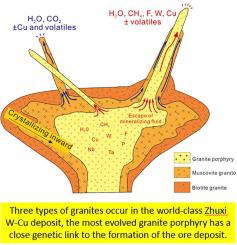当前位置:
X-MOL 学术
›
Ore Geol. Rev.
›
论文详情
Our official English website, www.x-mol.net, welcomes your feedback! (Note: you will need to create a separate account there.)
The effect of magma differentiation and degassing on ore metal enrichment during the formation of the world-class Zhuxi W-Cu skarn deposit: evidence from U-Pb ages, Hf isotopes and trace elements of zircon, and whole-rock geochemistry
Ore Geology Reviews ( IF 3.3 ) Pub Date : 2020-12-01 , DOI: 10.1016/j.oregeorev.2020.103801 Wei Zhang , Shao-Yong Jiang , Tianshan Gao , Yongpeng Ouyang , Di Zhang
Ore Geology Reviews ( IF 3.3 ) Pub Date : 2020-12-01 , DOI: 10.1016/j.oregeorev.2020.103801 Wei Zhang , Shao-Yong Jiang , Tianshan Gao , Yongpeng Ouyang , Di Zhang

|
Abstract The world-class Zhuxi W-Cu skarn deposit is located along the southeastern edge of the Yangtze Block, South China. Three types of granite (biotite granite, muscovite granite, and granite porphyry) are spatially related to the deposit. To decipher the W enrichment process in the Zhuxi magmatic system, we systematically study the whole rock major- and trace-element geochemistry of the three types of granites, together with U-Pb dating, Hf isotopes, and trace elements on zircon. All the Zhuxi granites are silica-rich, peraluminous, and sub-alkaline. Their major-elements exhibit a general decreasing trend with increasing SiO2 from 70.6 to 77.6 wt%, except P2O5, which has a positive correlation with SiO2. The Zhuxi granites are enriched in large ion lithophile elements (LILE) with notable negative Ba, Nb, Sr, and Ti anomalies. The total REE contents, (La/Yb)N, and (Eu/Eu*)N show a decreasing trend from the biotite granite, to the muscovite granite, and to the granite porphyry. The Zhuxi granites (eHf(t) = -13.6 to −6.8) were likely derived from partial melting of the Neoproterozoic Shuangqiaoshan Group. Fractional crystallization of feldspar, mica, zircon, and apatite caused the magma differentiation. Gradual cooling of the Zhuxi magmatic system from maximum temperatures of 800 ± 15 °C in the biotite and muscovite granites, and 720 °C in the granitic porphyry to minimum temperatures of 640 ± 20 °C (Ti-in-zircon thermometer) was accompanied by periodic degassing. The corresponding oxygen fugacity (expressed as ΔNNO) decreases from −5.4 to + 3.8 in the biotite granite, to −6.1 to + 2.7 in the muscovite granite, and to −10.5 to −1.8 in the granite porphyry. The most evolved granite porphyry has the highest contents of volatile (H2O, P, F, B, and CH4), silica, and Nb and Ta, and it is most likely responsible for the mineralization of the Zhuxi W-Cu deposit.
中文翻译:

世界级竹溪钨铜矽卡岩矿床形成过程中岩浆分异脱气对矿石金属富集的影响——来自U-Pb年龄、锆石Hf同位素和微量元素及全岩地球化学的证据
摘要 世界一流的竹溪钨铜矽卡岩矿床位于华南扬子地块东南缘。三种类型的花岗岩(黑云母花岗岩、白云母花岗岩和花岗岩斑岩)在空间上与矿床有关。为了破译竹溪岩浆系统中的W富集过程,我们系统地研究了三种类型花岗岩的整个岩石主微量元素地球化学,以及U-Pb定年、Hf同位素和锆石微量元素。所有竹溪花岗岩都富含二氧化硅、过铝质和亚碱性。除了与 SiO2 呈正相关的 P2O5 外,它们的主要元素随着 SiO2 从 70.6 wt% 增加到 77.6 wt% 呈现普遍下降趋势。竹溪花岗岩富含大离子亲石元素(LILE),具有显着的Ba、Nb、Sr和Ti负异常。REE 总含量、(La/Yb)N 和 (Eu/Eu*)N 从黑云母花岗岩到白云母花岗岩再到花岗斑岩呈递减趋势。竹溪花岗岩(eHf(t) = -13.6 至 -6.8)可能来源于新元古代双桥山群的部分熔融。长石、云母、锆石和磷灰石的分异结晶导致了岩浆分异。朱溪岩浆系统从黑云母和白云母花岗岩中的最高温度 800 ± 15 °C 和花岗斑岩中的 720 °C 逐渐冷却到最低温度 640 ± 20 °C(锆石钛合金温度计)通过定期脱气。相应的氧逸度(表示为 ΔNNO)在黑云母花岗岩中从 -5.4 降至 +3.8,在白云母花岗岩中降至 -6.1 至 +2.7,在花岗岩斑岩中降至 -10.5 至 -1.8。
更新日期:2020-12-01
中文翻译:

世界级竹溪钨铜矽卡岩矿床形成过程中岩浆分异脱气对矿石金属富集的影响——来自U-Pb年龄、锆石Hf同位素和微量元素及全岩地球化学的证据
摘要 世界一流的竹溪钨铜矽卡岩矿床位于华南扬子地块东南缘。三种类型的花岗岩(黑云母花岗岩、白云母花岗岩和花岗岩斑岩)在空间上与矿床有关。为了破译竹溪岩浆系统中的W富集过程,我们系统地研究了三种类型花岗岩的整个岩石主微量元素地球化学,以及U-Pb定年、Hf同位素和锆石微量元素。所有竹溪花岗岩都富含二氧化硅、过铝质和亚碱性。除了与 SiO2 呈正相关的 P2O5 外,它们的主要元素随着 SiO2 从 70.6 wt% 增加到 77.6 wt% 呈现普遍下降趋势。竹溪花岗岩富含大离子亲石元素(LILE),具有显着的Ba、Nb、Sr和Ti负异常。REE 总含量、(La/Yb)N 和 (Eu/Eu*)N 从黑云母花岗岩到白云母花岗岩再到花岗斑岩呈递减趋势。竹溪花岗岩(eHf(t) = -13.6 至 -6.8)可能来源于新元古代双桥山群的部分熔融。长石、云母、锆石和磷灰石的分异结晶导致了岩浆分异。朱溪岩浆系统从黑云母和白云母花岗岩中的最高温度 800 ± 15 °C 和花岗斑岩中的 720 °C 逐渐冷却到最低温度 640 ± 20 °C(锆石钛合金温度计)通过定期脱气。相应的氧逸度(表示为 ΔNNO)在黑云母花岗岩中从 -5.4 降至 +3.8,在白云母花岗岩中降至 -6.1 至 +2.7,在花岗岩斑岩中降至 -10.5 至 -1.8。



























 京公网安备 11010802027423号
京公网安备 11010802027423号